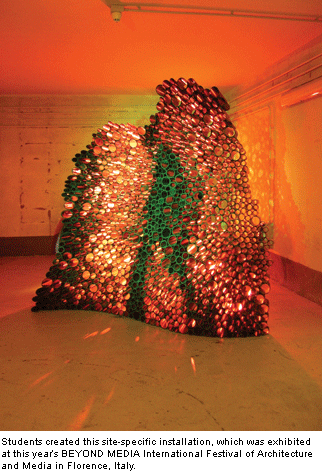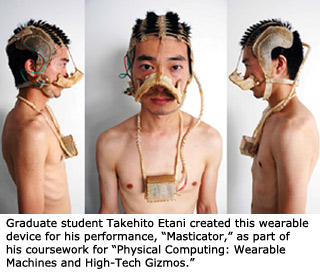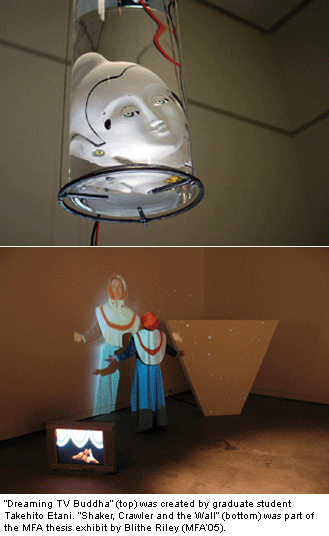A discussion of the arts doesn’t usually involve algorithms, sensors and solar energy—unless, of course, you’re part of an innovative series of digital arts classes in the College of Fine Arts at Carnegie Mellon. Here, students and faculty probe and scrutinize the wide array of possibilities that digital technology presents to art and design. With a visionary eye toward affecting lives in surprisingly varied and practical ways, students are learning and applying the concepts of digital expression to everything from entertainment and medicine to architecture and national security.

In the early decades of its 100-year existence, the College of Fine Arts—at first called the College of Fine and Applied Arts—followed a traditional model of arts education and prepared students for traditional careers. The talented student of architecture, for example, could be expected to graduate to a job in an architectural firm. With hard work, he or she would rise within the ranks.
Then along came the digital revolution, and everything changed. So strong was Carnegie Mellon in both the arts and computer science, that the inevitable marriage of the two happened here faster—and with greater success. In fact, back in the mid-1980s, Carnegie Mellon boasted the first computer-aided architecture design studio in the country.
“Technology changed entirely the way we practice,” notes Laura Lee, head of the School of Architecture. “And with that, also the way we educate our students.”
The close relationship between technology and the College of Fine Arts has continued to flourish. Now course descriptions and research projects can hardly be classified under any conventional category. Team teaching and joint appointments place professors simultaneously across the arts and in fields such as robotics and human computer interaction. And the students benefit most of all.

“College of Fine Arts students are very flexible,” says Lee. “Crossing boundaries is natural for us.”
Studio art courses that embrace computer science and all things digital now include “Physical Computing: Wearable Machines and High-Tech Gizmos” and “The Interactive Image.” In the latter, students design and create art using technical software algorithms and programming. Their exploration of signal filtering and kinetic simulation further expands the properties they consider, moving from the static to the dynamic and interactive.
For more than a decade, students from many disciplines have collaborated in robotic art studio courses. Class projects encompass artistic and technological concepts, as well as the cultural and social issues inherent in the field. Through hands-on experience, students explore the functionality of electronic components by creating robotic artwork that incorporates microcontrollers, sensors, actuators and alternative energy sources. They also consider how individual works of art can be networked to a system. Working with faculty who lead in their professions, they explore the artistic possibilities of emerging technologies, discovering technical, aesthetic and project management skills that generate a fresh approach to real-world issues.
“Our students are shaping the cultural and physical environment we live in,” says Susanne Slavick, head of the School of Art. “Whatever medium they choose to use and whatever their aesthetic sensibility, technology serves their creative vision.”

In the School of Architecture, students in Professor David Burns’ “Parametric Design” seminar were invited to create a site-specific installation for the 2005 BEYOND MEDIA International Festival of Architecture and Media, which opened last December in Florence, Italy. These students spent several months investigating the influence of contemporary media sources and the difficulty in deciphering and filtering the mass of information delivered. The result of this research led to a spatial construct that exploits the basic precepts of architecture: space and light.
By utilizing common construction materials, the students created a dynamic, fluid form that is inherently interactive, yet does not rely on projection, verbal information or any advanced technologies. Instead, the individual activates the installation by simply navigating the space and engaging the curvilinear form. The installation registers the presence of the individual by revealing the shadow of the human form on the opposite side. In this way, visual information is edited or filtered by the architecture.
Digital technology also leads to art that encompasses the full sensory realm in the “Advanced Interaction & Visual Interface” course. Artists and computer scientists collaborate to explore issues of design interfaces that activate vision, hearing and touch. They learn the design principles and information hierarchy of multi-modal presentations and user interactions. They walk away with a process for creating effective interface designs that can be applied to a wide range of future challenges in digital media.
By combining strengths in the arts, technology, science and the humanities, Carnegie Mellon is educating a new kind of professional—visionary artists who are tech-savvy, socially conscious and who make a difference in the world.
Related Links:
College of Fine Arts
Laura Lee
Susanne Slavick
David Burns
Takehito Etani
Links to other Carnegie Mellon Digital Artists:
Golan Levin
James Duesing'
Fabian Winkler
Suzie Silver
David Halsell
Ian Ingram
Pamela Jennings



